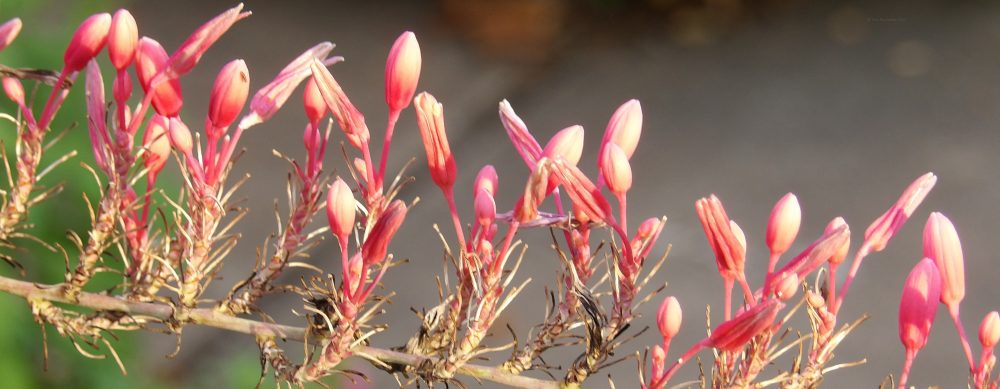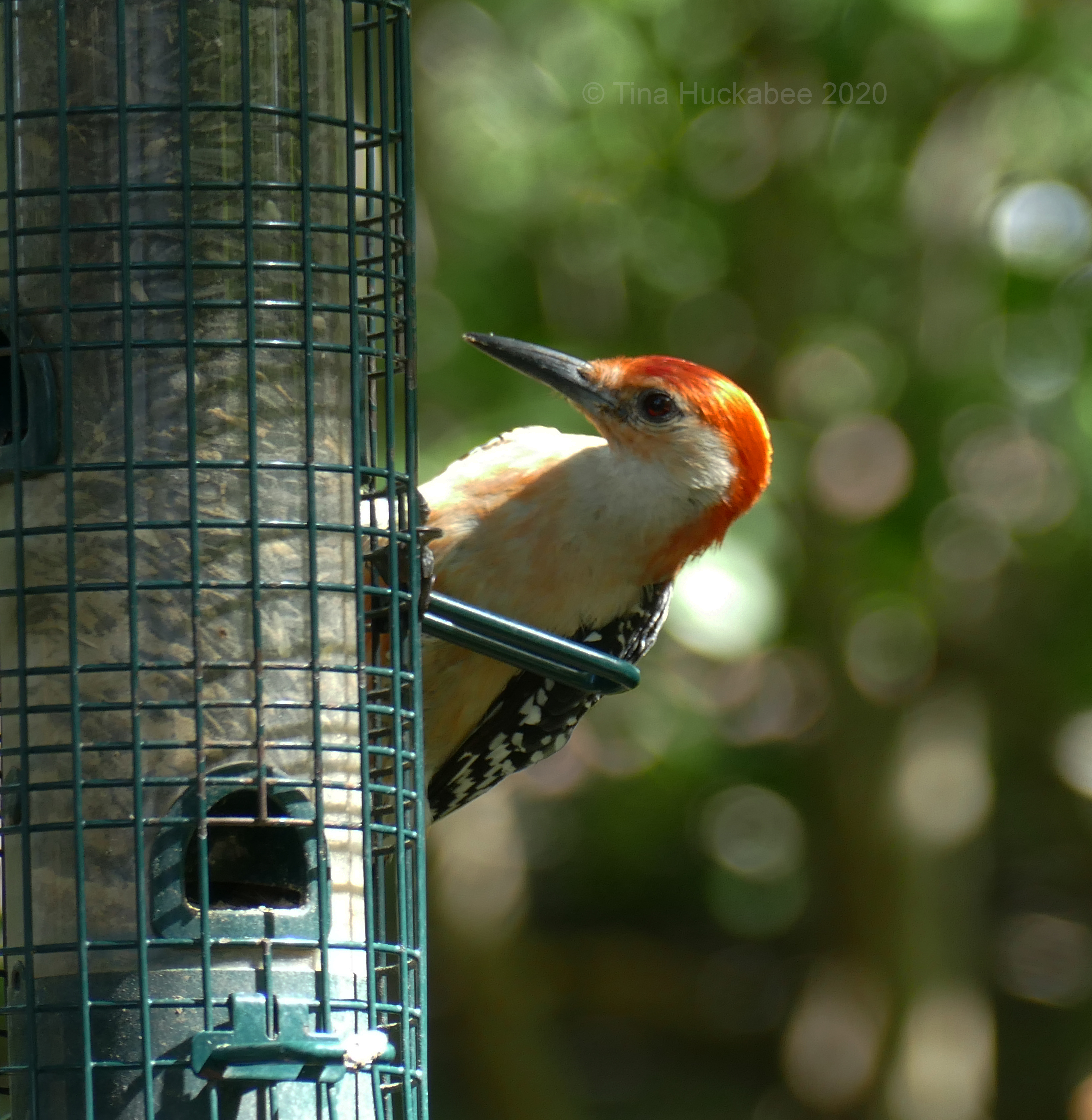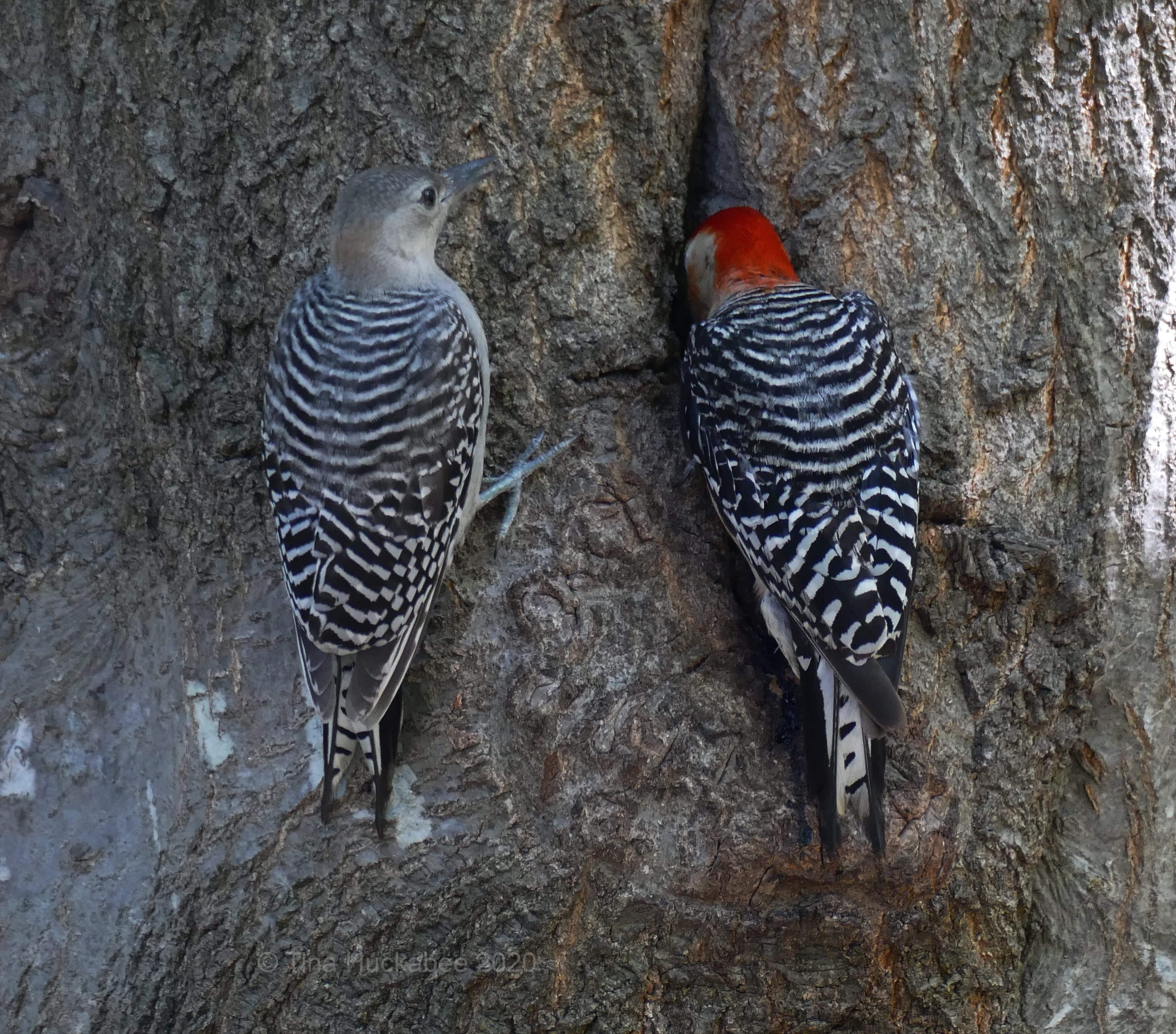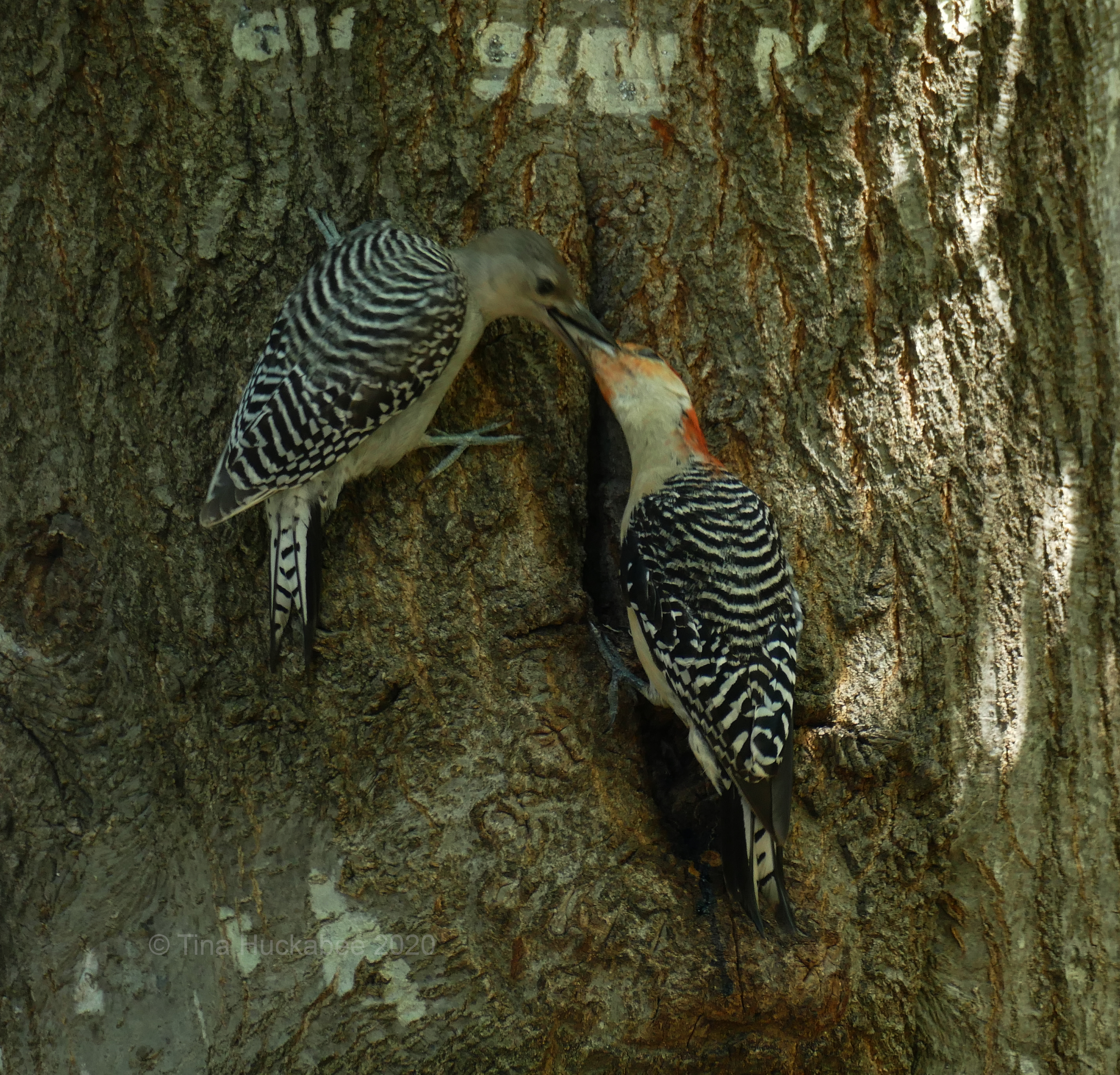Spring is new life and verdant growth, but is also well behind us and with it, the boom of babies born. There are still some critters in offspring production: insects, rodents, sparrows, doves and others, I’m sure, who produce youngins’ year-round, or nearly so. But for many of my local wildlife, their baby-rearing days for this year are drawing to a close. Baby birds are no longer helpless chicks, but are at fledgling and hatch-year stages; almost, though not quite, independent. Some lessons are still imparted by dedicated parents, like this handsome daddy Red-bellied Woodpecker, Melanerpes carolinus.
Such a pretty woodpecker! His head is most definitely red, but it’s the blush on his belly which gives this interesting bird its common name.
As dad picks up a black-oiled sunflower, baby red-bellied waits patiently on the trunk of the near-by Oak tree.
I observed this sweet familial scene for about 15 minutes. Dad flew to a feeder–mostly the sunflower, sometime the peanut–grabbed a morsel, then zipped back to the tree. When the snack choice was a sunflower seed, he’d spend a minute working the seed-coat off by hammering it as it was secured in the crevice of the bark. I wonder how he’d learned–by experience or from his parents–that by placing the seed in the crevice, he could better work the seed without its falling on the ground? Finding an easy source of available food and preparing it for a meal would a skill dad would want to pass on to junior. Modeling is the best form of teaching!
It’s not yet clear if the fledgling is male or female, but there is the suggestion of rosiness on the back of baby’s head. Time will tell. Male Red-bellied red heads begin between their eyes and cover over the tops of their heads. Females’ red heads start toward the backs of their heads, leaving their sweet faces mostly non-red.
The youngster knows a treat is coming and inches closer in anticipation!
Woodpeckers are common feeder birds, but they eat a wide variety of foods: all kinds of insects, spiders, nuts from a variety of trees, and seeds from annual and perennial plants. According to Cornell’s page on Red-bellied Woodpeckers, they sometimes eat lizards, nestling birds, and small fish. I’ve watched as woodpeckers (Downy Woodpeckers, too) glean insects from the barks of trees, but I’ve never witnessed any munching on protein from higher-up along the food chain.
I watched these two in my back garden as they hung out on my Red Oak tree, but commonly, I’ve seen Red-bellied Woodpeckers–mom, dad, kids–hitch themselves along the thick branches of my neighbor’s large front garden Arizona Ash tree. That tree now belongs to my SIL: different neighbor, same house and tree.
The ash is old and particularly weak-wooded. During a May storm, a major branch broke, landing in multiple pieces at the end of SIL’s driveway. It was rather dramatic! Thankfully, no one and nothing (except the branch) was damaged. Interestingly, the break occurred at an established Red-bellied Woodpecker nesting site. Especially in the last few years, I’d observed little red-heads hanging out from the hole that some dad started and some mom helped finish. This spring, before the break, bully European Starlings chased off the Red-bellied Woodpeckers, which was sad. In retrospect, I’m glad the Red-bellied babies weren’t in the nest when the storm came and the limb fell.
As neighbors stood around and marveled at the mess, recounting their own storm horror stories, I cast my eye on the portion that housed the woodpecker hole and nesting cavity. SIL was on-board with me taking it–for what, I wasn’t yet quite sure.
That piece of former woodpecker nest now sits in a garden just below the tree. 
The hole, drilled through the thick bark by determined, hammer-beaked woodpeckers, is a door/window into the tree. The nest cavity was fairly roomy and the sides of the hole were completely smooth, an exemplar of fine crafting by woodpeckers.
At the storm-driven break, obviously weakened by the nesting of generations of Red-bellied Woodpeckers, I filled the former nest with potting soil after plugging the woodpecker hole with crushed granite. I popped in a stem of Ghost Plant, Graptopetalum paraguayense and the plant is doing well in its new home. I just need to water from time-to-time. Ahem.
I enjoy observing the excellent parenting skills of the various birds who visit my garden. For a while longer, I’ll watch the juveniles’ antics as they mature. Autumn isn’t too far in the future and the new generation will eventually leave, moving on to their own territory to find mates and continue the cycle.
What wild things did you see in your garden this past month? Please leave a link, if you’d like to share your garden’s wild ways. Happy wildlife gardening!









Those are fantastic shots. It helps to be at the right place at the right time. For some reason my woodpecker visits have gone down over the years. I know a Red-bellied had a nest in the tree across the street. Maybe the neighbors have started feeding the birds. I still have a large group of juvenile cardinals. Yesterday I filled in a low spot with garden soil and they all enjoyed a dirt bath in it.
LikeLiked by 1 person
Thanks, Judy and you’re right. I have to be prepared and patient to get those shots.
Cardinals are another family of birds that are fun to watch as the parents, mostly dad, teach the kids how do be birds. So fun!
LikeLiked by 1 person
What a wonderful photo-illustrated story. Great photos as usual, Tina. I could not have been happier when my baby rearing days were over – it’s hard work tending to these helpless, willful little things…LOL! I like your new planter, too.
LikeLiked by 1 person
Parenting is hard work, especially with “willful little things” which is exactly how you want them to be. But, it gives us grey hair! Glad you like the planter.
LikeLiked by 1 person
Pingback: Wildlife Wednesday – A slice of life at the Marjoram Cafe | Frogend dweller's Blog
Tina, they are delightful! Very cute birds and lovely to anticipate the knowledge transfer. I love that you’ve re-appropriated their old nest/cavity. Very sentimental.
I’ve been pondering marjoram pollinators: https://wp.me/pM8Y1-7TZ
LikeLiked by 1 person
Both kinds of woodpeckers that I see regularly are charming birds, the Red-bellied and the Downy. I just love them. I’m glad you like the planter; I love the shape and the oddity of it.
LikeLiked by 1 person
Lovely images Tina, they are super looking birds.
LikeLiked by 1 person
Thanks, Brian. They really are very attractive birds.
LikeLike
Enjoyed reading your post. Starlings are certainly the bullies in this part of the world for sure!
LikeLike
I’m so glad! Starlings are bullies everywhere. Grrr!
LikeLiked by 1 person
GREAT SHOTS! It was great you were able to watch. Thanks for sharing!
LikeLike
I really enjoyed reading about the red bellied woodpeckers and the photos are perfect. Such a shame the old ash was lost but as you have written is was a good thing that the woodpeckers were not nesting in it.
As far as youngsters go, I don’t think I have seen any parent feeding off spring but then I can’t see across the yard very well since I don’t have any binoculars that work anymore. But I have seen multiple young titmice. chickadees, house finch and young cardinals. The woodpeckers just don’t come to my feeders but I am hoping that they eventually will. They are near by and I often hear them calling from the fig trees in my yard and from the utility poles that are behind my back fence.
LikeLike
I’m sorry the woodpeckers don’t come to your feeders, but it’s still nice that you hear them. I love both the Downy and Red-bellied calls, even when I can’t see their black-and-white-and-red selves.
LikeLiked by 1 person
I think almost everyone knows about raptors killing and eating other birds. Not being knowledgeable about birds myself, I’ll project onto the general public and conjecture that most people don’t realize—and wouldn’t be happy to learn—that these woodpeckers sometimes eat nestling birds. Similarly, the Squirrel Enthusiast website notes that “Although squirrels are predominantly herbivorous, they have been known to eat bird eggs, young birds, and smaller animals if their food source is scarce.” To generalize, I suspect many people have a sanitized picture of life in nature.
LikeLike
Absolutely correct, it’s a bird-eat-bird and squirrel-eat-squirrel world out there and NOT Disney-cute.
LikeLike
True. Imagine if Walt Disney had had Snow White eat the seven dwarfs.
LikeLike
I imagine each of those little dudes would be a decent meal. Maybe Bashful’s only a mid-day snack.
I just returned from a bike ride and as I pulled into my neighborhood, passed a house and heard squawking. Out flies a Cooper’s Hawk, squawking bird in hawk talons. Breakfast was either a grackle or blue jay, probably a fledgling. Easy pickins’. I always feel badly for the meal, but so it goes.
LikeLike
What a great series of photos, Tina! I so enjoy watching the fledglings and their parents. Right now, there are mockingbirds, chickadees, bluejays, and some sort of still-unidentified sparrowish bird still engaged in the feeding rituals. I can’t help thinking some, like the bluejays, might be raising a second family.
The sparrows at my feeders have multipled beyond my wildest expectations. There are easily a hundred of them, and when they aren’t feeding, they’re hanging out in some thick shrubbery. I didn’t raelize it until I walked past the bushes and they began to vibrate and sway as though the wind were blowing. It wasn’t — it was all those birdies!
LikeLike
They are so entertaining!! I’m sure you’re right about second broods–I think this Red-bellied is part of brood #2 and the Blue Jays have definitely had two sets of chicks.
Funnily enough, I don’t have that many house sparrows. I used to have more of them and despite their invasive nature, I’m fond of their chatter. I am having continual issues with starlings. Usually, by this time of year, I don’t have any, so this year is unusual. Such a funny story about the shrub! Some hawk should take notice of that!
LikeLike
They make the cutest sounds when being fed! We have several in our yard each day.
LikeLike
Haha–they really do. I just love the woodpeckers. Like the blue jays, they have so much personality.
LikeLike
Hi Tina, I loved this post. I didn’t know much about red-bellied woodpeckers, but I feel like I do now. I just knew they came to my feeders a lot in winter. Thank you for this fabulous information. ~~Dee
LikeLike
Aren’t they darling? I’m glad you enjoyed the post!
LikeLike
I loved these photographs. Very sweet. We haven’t seen any Red Bellies lately, though we always see lots of Downies.
LikeLike
Thanks, Jason. I love those little Downies, too–so cute!
LikeLiked by 1 person